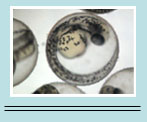

Home
Common Techniques
Classroom Experiments
Virtual Experiments
Tutorials
Games
Glossary
Links
Publishing
Opportunities
About This Site
Contact Us
ZFIN
Cite Us
casanova Experiment
Page 1: Genetic Mutations
Before the details of the cassanova mutation experiment can be explained, it is nessecary to provide some background information on genetic mutations.
In biology, mutations are changes to the DNA sequence of the genetic material of an organism. Most of the mutations that are used to study developmental biology affect the portion of the gene that encodes the protein, potentially having an effect on the organism, and so we will focus on this kind of mutation here. In multicellular organisms, mutations can be subdivided into germ line mutations, which can be passed to offspring, and somatic mutations, which are not transmitted to offspring. The mutations studied in zebra fish are passed down from parent to offspring, thus they are termed germ line mutations.
Genetic mutations can also take a variety of forms:
- Loss-of-function mutations are the result of the gene product having reduced or no function.
- Gain-of-function mutations change the gene product such that it gains a new and abnormal function.
- Dominant negative mutations (also called anti-morphic mutations) have an altered gene product that acts antagonistically to the wild-type allele. These mutations usually result in an altered molecular function (often inactive) and are characterized by a dominant or semi-dominant phenotype.
- Lethal mutations are mutations that lead the death of the organisms which carry the mutations.
As is clearly obvious, genetic mutations have a wide spectrum of both causes and effects.